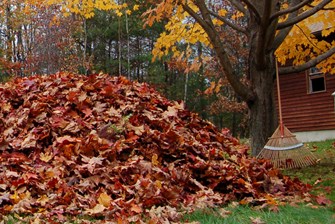
Last week’s frosty temperatures and windy conditions certainly brought down a lot of leaves. If we leave them to overwinter on the lawn, fallen leaves can cause problems as they build up and pack down, encouraging fungus and organisms that can cause damage.

Raking leaves by hand can be a stimulating experience, best accomplished on a non-windy day. I find it helpful to use a tarp and garden cart, and pack-down the leaves before I transport them to the compost pile. Combining grass clippings and food wastes with leaves in the compost helps speed leaf decomposition to develop a finished product sooner.
Using a mulching-type lawnmower (without a leaf bag) enables chopped-up leaves to sift down into the lawn, adding valuable nutrients to the soil. You may need repeated passes to reduce the leaves to sufficiently small particles.
Running a mower equipped with a leaf-catcher bag over the fallen leaves makes the leaves easier to collect and also chops them up. I spread 3-6” of chopped-up leaves as mulch around trees and shrubs, and covering the ground where my cutback herbaceous perennial garden now looks so naked. This layer of leaves is nutritionally beneficial, also creating a mulch that discourages weed germination, insulates and helps moderate winter soil temperature fluctuations.
These days it seems to be general practice to remove newly-fallen leaves and old mulch from landscaped beds down to bare soil, and then apply fresh mulch. I personally support removing weeds and unsightly debris, but prefer leaving already-decomposing organic matter in place to add “life” to the soil. It seems so illogical to remove one type of organics, only to replace it with another, particularly when the existing matter is working just fine. If you want that fresh-mulch appearance, it’s better to wait until spring. Even then, I prefer fluffing existing mulch, topping with a light layer of new.
Now that plants have dropped their leaves, it’s easier to spot undesirables that have moved-in where they’re not wanted. In my garden Vinca, Pachysandra and ivy have a way of expanding their territory, seriously crowding my shrubs. This is the time to trim them back before they become really unmanageable. It’s also easy to identify truly invasive plants like bittersweet, buckthorn (Rhamnus), multiflora rose, Virginia creeper and poison ivy. Physically pulling out their roots rather than trying to control them chemically is the right way to manage them.
November and early December are invigorating times to work outdoors and enjoy the crisp air, particularly if we are accomplishing an important task. And if we consider fallen leaves to be a resource rather than a burden, it certainly helps makes this work more gratifying.







